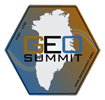Science Summary
The Arctic and Antarctic are undergoing rapid changes in their marine, glacial, ecological, atmospheric, and social systems. Addressing the societally relevant consequences of this change, which are local and global in scope, requires a more diverse and integrative U.S. polar STEM community with leaders prepared for international and cross-cultural collaborations. Dartmouth will lead the U.S. component of two international efforts to develop inclusive polar STEM learning opportunities for high school, undergraduate, and graduate students that will help build capacity for U.S. leadership in the polar regions. The Joint Science Education Project (JSEP) includes a close collaboration with international and Indigenous partners in Greenland and Denmark, and the Joint Antarctic School Expedition (JASE) includes a partnership with Chile. The field-based JSEP program will immerse U.S. students in experiential learning in Kangerlussuaq and Summit Station, Greenland. JSEP will include a remote short course for U.S. high school students to learn about the Arctic through data-focused activities. The JASE program includes a partnership with the Chilean Antarctic Institute to co-lead a virtual symposium for students to share Arctic and Antarctic research. Applications for both programs will be encouraged from students across the U.S. and recruitment will focus on reaching students who have limited access to STEM experiences and who come from groups historically excluded from STEM fields.
The JSEP and JASE experiences will be developed around a unique intergenerational mentor-mentee model that gives U.S. high school students access to undergraduate and graduate students as near-peer mentors and opportunities for the student mentors to develop their communication and outreach skills. The effort includes an evaluation and dissemination of the inclusive models for U.S. polar STEM education and research programs that prioritize diversity, collaboration, communication, outreach, cultural sharing, and building sustained relationships with Arctic and Antarctic partners. This includes implementing new approaches for recruiting and supporting students whose opportunities for polar STEM have been limited by factors such as gender, race, ethnicity, and socio-economic and ability status. Results will inform future efforts to successfully provide education and research experiences to U.S. students interested in polar science and engineering. This project will expand an international and diverse network of students, educators, and scientists with skills for polar research, outreach, and STEM careers. JSEP and JASE will involve at least 100 U.S. high school students and up to 20 undergraduate or graduate students with a goal that many of these students come from groups historically excluded from STEM fields. Students, educators, and scientists involved with this project will gain exposure to field-based polar research and improve their skills for: science communication; cross-cultural and international collaborations; framing scholarship to meet the needs of Arctic communities; and recognizing and respecting Indigenous knowledge. The undergraduate and graduate students will receive hands-on training in interdisciplinary research and outreach, which will prepare them as STEM leaders with skills for broadening impacts of their future scholarship. The project also provides significant opportunity for science diplomacy and to strengthen relationships by engaging our Arctic and Antarctic partners in all aspects of project planning, implementation, assessment, and reporting. Assessments will allow evaluation of how the following pedagogical elements impact outcomes for U.S. students (high school, undergraduate, and graduate): field-based versus virtual, hands-on activities, interdisciplinary curriculum, Indigenous perspectives, intergenerational mentor-mentee relationships, and a multicultural setting. Results will inform future efforts to successfully provide education and research experiences to U.S. students interested in polar science and engineering.
